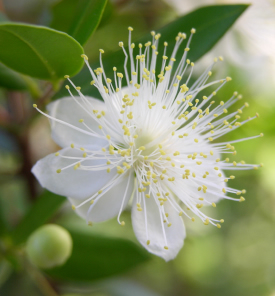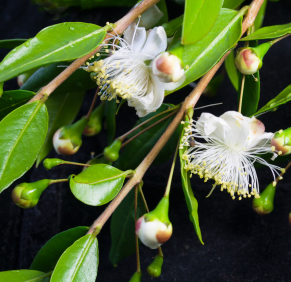Myrtle Myrtus communis

Myrtus communis flower
- Common Names
- Myrtle
- Botanical Name
- Myrtus communis
- Family
- MYRTACEAE
Medicinal Uses & Benefits of Myrtle
![]() How to Use|
Side Effects |
Plant & Garden|
Aromatherapy Oil |
How to Use|
Side Effects |
Plant & Garden|
Aromatherapy Oil |
- Medicinal Uses: * Aromatherapy
* Bronchitis
- Properties: * Antibacterial * Antirheumatic * AntiViral * Aromatic * Astringent * Astringent * Calm * Carminative * Cordial * Rubefacient * Stimulant * Stomachic
- Parts Used: Leaf and berries
How to Use: Myrtle
The leaves of the myrtle tree are very aromatic and the plant has a number of medicinal uses. In traditional herbal medicine myrtle has been taken internally for urinary infections, digestive problems, bronchial congestion, and dry coughs. In Ayurveda it is seen as a treatment for cerebral infections, most notably epilepsy. Myrtle has also been used at various times as an astringent, an antiseptic and a decongestant. 1
Preparation Methods & Dosage :Myrtle leaves can be used in teas. The essential oil is used in aromatherapy.
Myrtle Remedies
Myrtle : Essential Oil Profile
The oil has a distinct, spicy, camphor-like aroma. The better oils exhibit a sweeter, fresher note.
 In the Kitchen: Myrtle leaves can be used as a tea, and can be substituted for bay leaves in cooking. Myrtle branches can be used as firewood, for grilling it transmits a spicy aromatic flavor to meats and vegetables.
In the Kitchen: Myrtle leaves can be used as a tea, and can be substituted for bay leaves in cooking. Myrtle branches can be used as firewood, for grilling it transmits a spicy aromatic flavor to meats and vegetables.
Myrtle Side Effects: Avoid in pregnancy
Plant Description

Myrtle flowers and leaves
- Flowers:5 petal star like flower, usually white
- Plant Class:Flowering Evergreen Shrub
- Leaves: Fragrant with essential oil, 3-5 cm long
- Fruit: Edible blue-purple berries with several seeds.
- Preferred Habitat:
- Flowering Season:
- Distribution:Native to the Mediterranean, Southern Europe and Northern Africa











